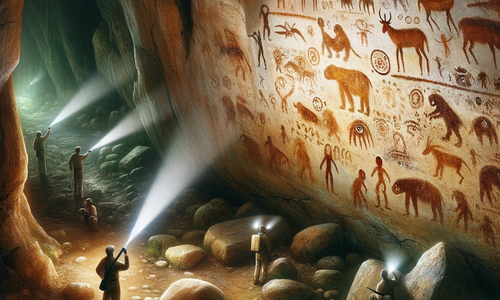
Set within treacherously steep cliffs, and hidden away valleys of northeast Brazil, is some of Southeast America’s most significant and spectacular rock-art. Most of the art so far discovered from the ongoing excavations comes from the archaeologically important National Park of the Serra da Capivara in the state of Piaui, and it is causing quite a controversy. The reason for the uproar? The art is being dated to around 25,000 or perhaps. According to some archaeologists, even 36,000 years ago. If correct, this is set to challenge the widely held view that the America were first colonized from the north, via the Bering Straits from eastern Siberia at around 10,000 BC, only moving down into Central and South America in the millennia thereafter.
Prior to the designation of 130,000 hectares as a National Park, the rock-art sites were difficult to get to, and often dangerous to enter. In ancient times, this inaccessibility must have heightened the importance of the sites, and indeed of the people who painted on the rocks. Wild animals and human figures dominate the art and are incorporated into often-complex scenes involving hunting, supernatural beings, fighting and dancing. The artists depicted the animals that roamed the local ancient brushwood forest. The large mammals are usually painted in groups and tend to be shown in a running stance, as though trying to escape from hunting parties. Processions – lines of human and animal figures – also appear of great importance to these ancient artists. Might such lines represent family units or groups of warriors? On a number of panels, rows of stylized figures, some numbering up to 30 individual figures, were painted using the natural undulating contours of the rock surface, so evoking the contours of the surrounding landscape. Other interesting, but very rare, occurences are scenes that show small human figures holding on to and dancing around a tree, possibly involved in some form of a ritual dance.
Due to the favourable climatic conditions, the imagery on many panels is in a remarkable state of preservation. Despite this, however, there are serious conservation issues that affect their long term survival. The chemical and mineral quantities of the rock on which the imagery is painted is fragile and on several panels it is unstable. As well as the secretion of sodium carbonate on the rock surface, complete panel sections have, over the ancient and recent past, broken away from the main rock surface. These have then become buried and sealed into sometimes-ancient floor deposits. Perversely, this form of natural erosion and subsequent deposition has assisted archaeologists in dating several major rock-art sites. Of course, dating the art is extremely difficult given the non-existence of plant and animal remains that might be scientifically dated. However, there are a small number of sites in the Serra da Capivara that are giving up their secrets through good systematic excavation. Thus, at Toca do Boqueirao da Pedra Furada, rock-art researcher Niéde Guidon managed to obtain a number of dates. At different levels of excavation, she located fallen painted rock fragments, which she was able to date to at least 36,000 years ago. Along with the painted fragments, crude stone tools were found. Also discovered were a series of scientifically datable sites of fireplaces, or hearths, the earliest dated to 46,000 BC, arguably the oldest dates for human habitation in the America.
However, these conclusions are not without controversy. Critics, mainly from North America, have suggested that the hearths may in fact be a natural phenomenon, the result of seasonal brushwood fires. Several North American researchers have gone further and suggested that the rock art from this site dates from no earlier than about 3,730 years age, based on the results of limited radiocarbon dating. Adding further fool to the general debate is the fact that the artists in the area of the National Hark tended not to draw over old motifs (as often occurs with rock-art), which makes it hard to work out the relative chronology of the images or styles. However, the diversity of imagery and the narrative the paintings create from each of the many sites within the National Park suggests different artists were probably making their art at different times, and potentially using each site over many thousands of years.
With fierce debates thus raging over the dating, where these artists originate from is also still very much open to speculation. The traditional view ignores the early dating evidence from the South American rock-art sites. In a revised scenario, some paleo–anthropologists are now suggesting that modern humans may have migrated from Africa using the strong currents of the Atlantic Ocean some 60,000 years or more ago, while others suggest a more improbable colonization coming from the Pacific Ocean. Yet, while either hypothesis is plausible, there is still no supporting archaeological evidence between the South American coastline and the interior. Rather, it seems possible that there were a number of waves of human colonization of the Americas occurring possibly over a 60,000-100,000 year period, probably using the Bering Straits as a land bridge to cross into the Americas.
Despite the compelling evidence from South America, it stands alone: the earliest secure human evidence yet found in the state of Oregon in North America only dates to 12,300 years BC. So this is a fierce debate that is likely to go on for many more years. However, the splendid rock art and its allied anthropology of northeast of Brazil, described here, is playing a huge and significant role in the discussion.